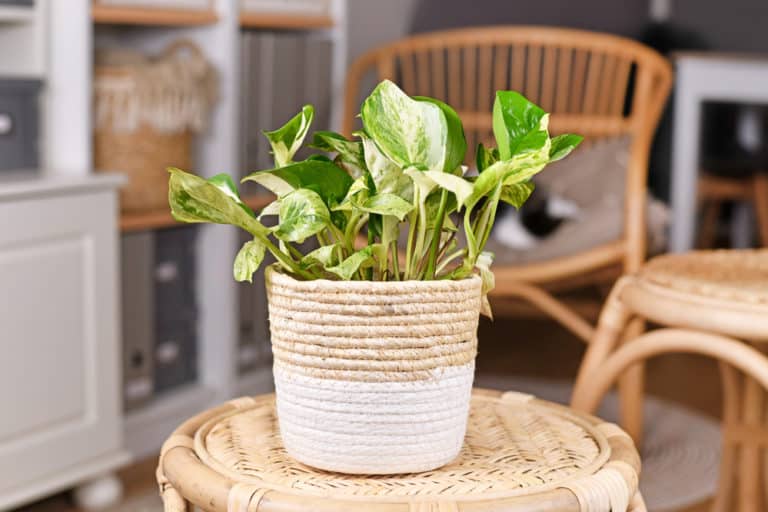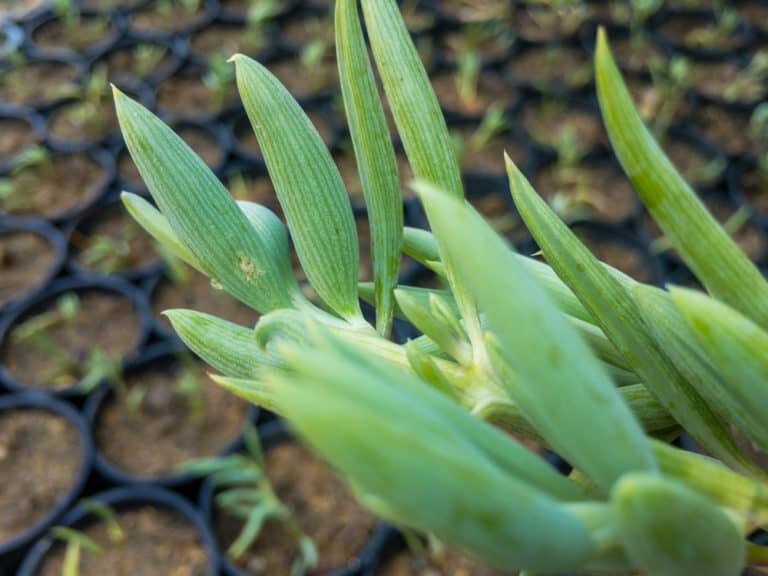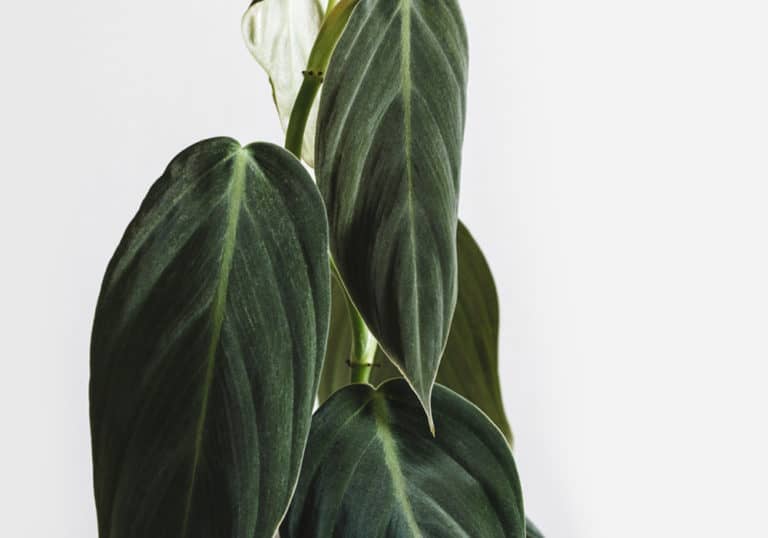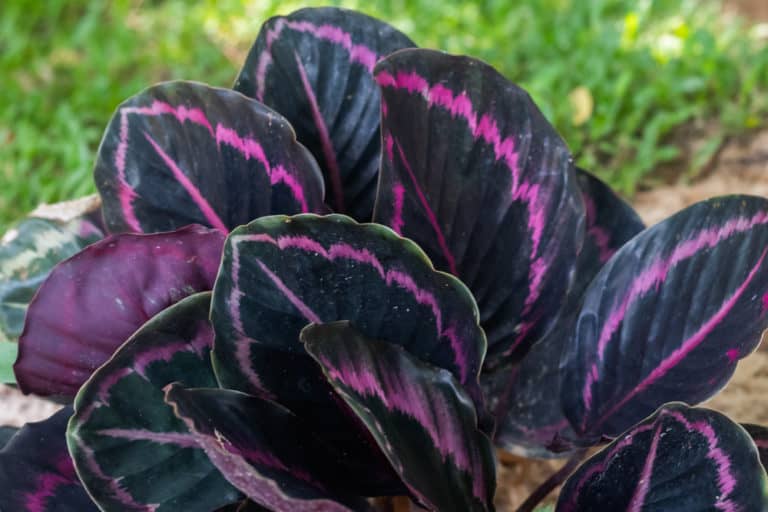Epipremnum Aureum ‘Hawaiian Pothos’ Care Guide (2024)
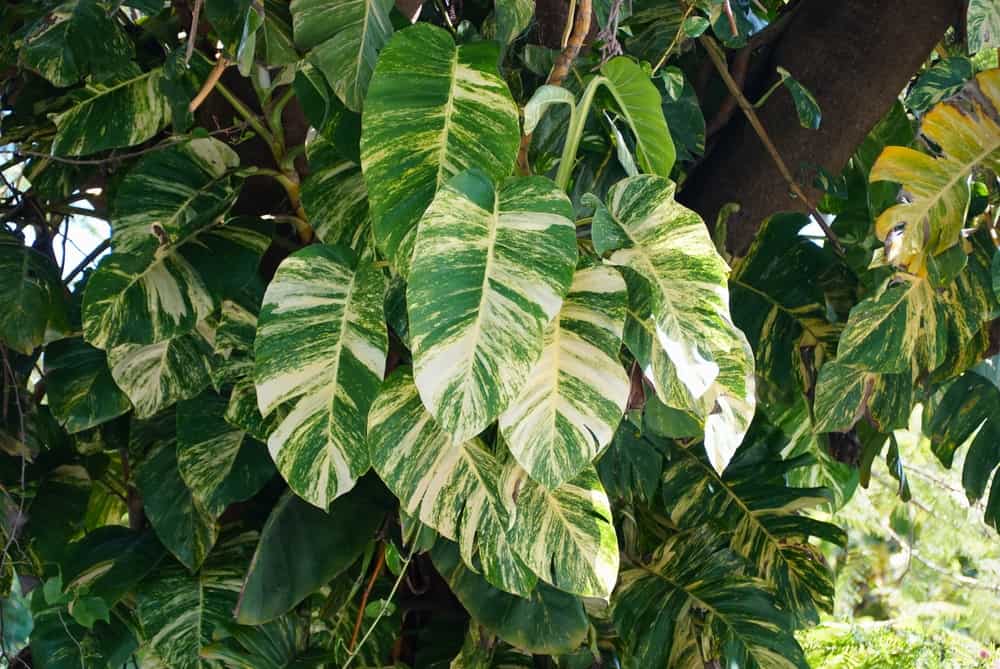
Hawaiian Pothos is an outstanding foliage plant that is a great addition to any indoor garden.
It’s large, dramatically patterned leaves will add a tropical feel to any space, and it’s one of the easiest houseplants to take care of, even for beginners.
Grow giant Hawaiian Pothos outdoors in hot weather or indoors year-round.
| Scientific Name | Epipremnum aureum ‘Hawaiian’ |
| Common Name | Hawaiian Pothos |
| Light | Medium indirect sunlight |
| Watering | Water if the top half of the soil is dry |
| Temperature | 64-77°F (18°C to 25°C) |
| Hardiness Zone | 11, 12 |
| Humidity | 50-70% |
| Soil Type | Loose, quick-draining |
| Soil pH | 5.5-7 (neutral to mildly acidic) |
| Fertilizing | A balanced feed once a month in spring and summer |
| Repotting | Every 2 years |
| Pruning | Beginning of the growing season |
| Propagation | Root in water |
| Toxicity | Toxic to humans and pets |
| Mature Size | 72 inches as a houseplant |
| Bloom Time | No flowering |
What’s Unique About Hawaiian Pothos?
Hawaiian Pothos plants are native to French Polynesia and have the lush look that you would expect from a tropical jungle plant.
Its large, glossy leaves are bright green and overlaid with brilliant streaks of gold, creating a vibrant picture wherever it’s placed.
Its vining habit allows it to either trail from a hanging basket or be trained up a support for a vertical accent.
At the same time,the Hawaiian Pothos plant is easy to grow with a minimal amount of care. This makes it ideal for someone who doesn’t have the skills or time for a more demanding plant.
Hawaiian Pothos Care
Growing Hawaiian Pothos is easy if you pay attention to a few simple rules of Hawaiian Pothos plant care.
Keep the plants in a warm spot out of direct sunlight, water sparingly, and feed them once a month to keep the foliage lush and full.
With this giant Hawaiian Pothos care, your plants will thrive.
Light
Hawaiian Pothos light requirements are undemanding.
In the south Pacific jungles where it originates, Hawaiian Pothos is used to bright, indirect light filtered through the trees. This translates to about 10,000-20,000 lux
You can easily replicate these conditions in your home without any special equipment. Place your Hawaiian Pothos in an east window, or in a south-facing room out of the direct sun.
Avoid full sun, which will bleach or even scorch the leaves. However, keeping them in too dark a room will fade the golden variegation that makes them so desirable.
You can accommodate your giant Hawaiian Pothos light needs by moving them from low-light to medium-light spaces when necessary to maintain their vibrant appearance.
Watering
The watering needs for Hawaiian Pothos are simple: dry is better than wet.
In their native jungles, these plants are used to well-draining soil that does not retain water, so the worst thing for them is to have soil that is too wet.
Do not water giant Hawaiian Pothos unless at least the top half of the soil is dried out. Check this with your finger or a moisture meter.
You can also estimate the dryness of the soil by seeing how heavy the pot is: if the soil is full of water, it will weigh more.
For effective Hawaiian Pothos watering, soak the soil and then let the excess drain out.
Temperature
This is a jungle plant, so it’s not surprising that the Hawaiian Pothos temperature range is on the tropical side.
The ideal temperature for giant Hawaiian Pothos is from 60-90°F (15-32°C), and it has limited temperature tolerance below 50°F (10°C). It has no frost hardiness and will be killed by freezing temperatures.
This means that unless you live in zones 11 or 12, you will have to grow it as a houseplant, or at least overwinter it inside and only bring it outside in summer when hot weather returns.
Indoors, keep it away from fans or air conditioning vents that could chill and damage the tender foliage.
Humidity
Once again, the jungle origin of this plant determines Hawaiian Pothos humidity requirements.
They love moist air, thriving in an environment with a humidity level between 50-75%, but can tolerate 40% without harm.
If you cannot provide the ideal humidity for giant Hawaiian Pothos, you may find the tips of its leaves starting to turn brown.
Try to place your Hawaiian Pothos in spaces that naturally have moister air, such as bathrooms and kitchens.
If that is not possible, you can mist the plants every few days. Use distilled water as the mineral salts in tap water can build up on the leaves.
Soil
Hawaiian Pothos soil should be very loose and well-draining, as these plants do not tolerate wet soil at all.
The ideal pH level for giant Hawaiian Pothos is neutral to slightly acidic, from about 5.5 to 7.
You can use a commercial soil mix for cacti or succulents, as they have very similar soil requirements.
If you want to make your own custom-blended soil for giant Hawaiian Pothos, use a standard houseplant potting soil. Add equal amounts of perlite, sphagnum moss, and sand to improve the drainage.
Coconut coir can be substituted for sphagnum if you prefer to use a more environmentally friendly product.
Fertilizer
You can use a couple of different types of fertilizer for giant Hawaiian Pothos, both of which will keep its foliage lush throughout its growing season.
Apply a balanced 20-20-20 liquid fertilizer once a month throughout the spring and summer. Stop using fertilizer when it enters its dormant phase in fall and winter.
Add the Hawaiian Pothos fertilizer at the same time that you water the soil to ensure even distribution to the roots.
You can also add a slow-release fertilizer with a fertilizer ratio of 10-10-10 in granular form to the soil in early spring, which should last throughout the growing season.
Potting & Repotting
Hawaiian Pothos repotting only needs to be done every year or so. You will know it’s time when roots start to grow out of the drainage holes on the bottom. Early spring before it exits its dormant phase is best.
When repotting giant Hawaiian Pothos, don’t increase the pot size too much: only go up 2 inches in diameter.
The single most important thing to look for when potting is a pot with drainage holes so that water can drain out.
Fill the new pot with fresh potting soil, leaving room for the root ball. Plant it to the same level as before and water well, letting the excess water drain out.
Pruning
Giving your Hawaiian Pothos an occasional trim can help keep it looking its best.
Remove any dead or damaged leaves at any time. If you cut the stem just above a leaf node, fresh new growth will be encouraged.
Cutting giant Hawaiian Pothos can also be done to shape the plant. You can cut out up to one-third of the plant at a time, usually in early spring or autumn.
Do not attempt Hawaiian Pothos pruning when it is actively growing.
Use sharp scissors or a knife to make clean cuts.
You may wish to train your Hawaiian Pothos up a sphagnum pole at the same time that you prune.
Propagation
Hawaiian Pothos propagation is easy and is a great way to create more plants for yourself or others.
The easiest way to propagate giant Hawaiian Pothos is by rooting stem cuttings.
Choose 4-6 inch stems with at least 2 or 3 leaves, and cut them off just below a leaf node. Remove all but 2 leaves at the tip of the stem, and place the cuttings in a jar of water.
Place it in a bright spot out of the direct sun, and change the water every few days.
It should only take a month or so before the roots are about an inch long and you have new little plants ready to pot up.
Also, make sure to check out our in-depth snow queen Pothos plant care guide.
Common Problems of Hawaiian Pothos
Most Hawaiian Pothos problems can be solved by paying close attention to its preferred growing conditions.
Aside from keeping an eye out for bugs on the leaves, make sure that it’s kept in a bright, warm spot out of the direct sun and water it sparingly.
Following those simple rules should prevent most problems with giant Hawaiian Pothos.
Pests
Hawaiian Pothos pests are not terribly common, but occasionally you may notice some insect infestations.
The common bugs on giant Hawaiian Pothos are the usual houseplant culprits: mealybugs and scales, and less commonly, aphids and spider mites.
Mealybugs can be identified by the presence of cottony masses on the underside of leaves.
Scales look like small brownish bumps on stems and leaves.
Spider mites leave tiny white or yellow spots on the top side of leaves.
Aphids are light green in color and suck the sap from leaves and stems.
Use non-toxic sprays such as insecticidal soap, nem oil, or pyrethrum to control infestations.
Diseases
Giant Hawaiian Pothos is rarely affected by diseases, and most can be prevented or cured with proper growing conditions.
Most Hawaiian Pothos diseases are the result of overwatering, or failing to provide adequate drainage, causing the plant to sit in wet soil.
Bacterial leaf spot thrives in wet conditions. You can identify it by the development of yellow blotches on the leaves, which will die and drop off. Cut out the diseased parts and spray with a fungicide.
Root rot is the result of too-wet soil. If the roots have turned brown and soft, discard the plant, but if you catch it early, cut out the diseased parts and plant in a pot with better drainage.
Growing Problems
You may encounter a few growing problems with your Hawaiian Pothos, but you usually just need to tweak growing conditions to cure your sick plant.
If your Hawaiian Pothos leaves are losing their distinctive yellow variegation, it’s probably getting too much sunlight. Move it out of the direct sun and it should bounce back.
If the leaves are drooping, check the soil. If it’s too wet, cut back on watering. If it’s too dry, water more frequently.
If the edges of the leaves are turning brown and crispy, you should find a warmer spot away from cool drafts.
If the leaves are yellowing, you may be fertilizing too much. Cut back on the frequency or strength of fertilizer.
Toxicity of Hawaiian Pothos
Giant Hawaiian Pothos is toxic to both humans and animals because of the calcium oxalate that is in all parts of the plant.
Its toxicity is fairly low, meaning that anyone would have to eat very large quantities for a fatal dose, but even small amounts can be quite serious, especially for smaller creatures like pets or toddlers.
For Humans
Hawaiian Pothos is definitely toxic for humans.
Adults are unlikely to try to eat it, but children may sometimes try eating some of it, causing swelling of the lips, tongue, and mouth, and vomiting.
In such a case, take the child to the emergency room for medical attention.
To prevent any exposure to children, keep plants out of reach of young kids.
Adults are more likely to suffer from an allergic reaction on their skin from working with the plants. Rinse the skin thoroughly with soap and water, and use an antihistamine cream to soothe any rash or irritation that develops.
For Pets
Hawaiian Pothos is also toxic for cats and dogs, so if you want both pets and these lovely plants, you need to be aware of the dangers and how to prevent them from eating it.
If a cat or dog eats even a small part of a leaf, they may suffer from swollen tongue and throat, which could lead to difficulty breathing. You may first notice drooling or vomiting after ingesting.
Take your pet to the veterinarian as soon as possible for medical care.
To keep your pets safe, grow Hawaiian Pothos where they cannot reach it, like on high shelves or hanging baskets.
Hawaiian Pothos Appearance
The Hawaiian Pothos appearance is lush and tropical. Its large, glossy leaves have a striking combination of bright green and gold, creating a dynamic appearance.
While it is related to Golden Pothos, its leaves are much larger and the color variegation is more dramatic.
As well, its spreading growth habit will quickly result in an imposing component of your indoor garden or outdoor tropical oasis.
Foliage
The foliage of Hawaiian Pothos is definitely the star of the show. Under ideal conditions they can grow up to more than a foot long and wide, each leaf streaked with brilliant yellow and bright green.
You are likely to only see juvenile leaves on your potted Hawaiian Pothos. They have no holes or indentations and may be as much as a foot long.
If you are fortunate enough to live in a tropical zone where your Hawaiian Pothos can be grown outdoors year-round, you may see mature leaves up to 3 feet long, with holes along the center rib.
Flowering
Unless you are growing your Hawaiian Pothos outdoors in a tropical location, you are very unlikely to ever see a giant Hawaiian Pothos flower.
Hawaiian Pothos flowering can only happen with mature plants. Potted Hawaiian Pothos are only the juvenile form of the plant, as the mature plants are far too big for growing in pots indoors.
In their native jungle, Hawaiian Pothos develops bunches of erect stems with cream and purple spathes wrapped around the spadix.
Instead of trying to create the conditions that would make blooming possible, it’s best to accept that you have a spectacular foliage plant.
Size and Growth
In its native jungles in French Polynesia, a mature Hawaiian Pothos vine can extend up to 65 feet, but your houseplant will not get anywhere near that size.
A juvenile vine in a pot can be expected to grow up to 4 feet long and 1 to 2 feet wide, whether it’s trailing out of a hanging basket or trained up a moss pole.
Hawaiian Pothos has a fairly rapid growth rate. During its growing season, a plant can grow as much as a foot a month, so within a year you will have an impressive size of Hawaiian Pothos.
Hawaiian Pothos Fragrance
There is no Hawaiian Pothos fragrance.
The foliage has no scent, and since it does not flower in cultivation, there is no source for fragrance.
This makes it a good choice for individuals who are sensitive to fragrances, and in public settings such as medical offices or nursing homes that are fragrance-free.
However, the spectacular appearance of a full-size potted Hawaiian Pothos makes up for any lack of scent.
You can pair it with other plants such as jasmine or gardenia. That way, you can have the perfume of flowers wafting through your house while at the same time enjoying the visual show of your Hawaiian Pothos.
Suggested Uses for Hawaiian Pothos
Its vining habit and magnificent foliage make Hawaiian Pothos a great addition to your plant collection.
Indoors, you can create a striking vertical element in one of two ways.
You can plant it in a hanging pot and let the leaves cascade down.
Alternatively, you can plant it in a regular pot and train it up a sphagnum pole as it grows.
Wherever you place it indoors, it’s going to help purify the air of benzene and formaldehyde.
You can move your pot outdoors in the hot summer weather, or plant it in the ground year-round if you’re in zones 11 or 12.
FAQ
What is Hawaiian Pothos?
Hawaiian Pothos is a tropical vining plant native to the French Polynesian islands that is cultivated as a potted houseplant for its colorful and large leaves.
How to identify Hawaiian Pothos?
Hawaiian Pothos is a vining plant with leaves that grow up to a foot long, with streaks of intense yellow over bright green, glossy leaves.
How to care for Hawaiian Pothos?
Grow your Hawaiian Pothos in loose, well-draining soil and keep it in warm, humid conditions in bright but indirect light. Water sparingly and fertilize monthly.
How to grow Hawaiian Pothos indoors?
Hawaiian Pothos should be kept in a warm location out of the full sun, and protected from cold drafts. It can be planted in a hanging pot.
How to grow Hawaiian Pothos outdoors?
Hawaiian Pothos can be moved outdoors in summer in temperate climates. In zones 11 or 12 it can be planted permanently outside and allowed to grow to a mature size.
How fast does Hawaiian Pothos grow?
Hawaiian Pothos has a moderately fast growth rate. It can grow up to a foot a month in its growing seasons of spring and summer.
How tall does Hawaiian Pothos grow?
The juvenile form of Hawaiian Pothos that is cultivated indoors in pots will grow to about 6 feet tall and 1 or 2 feet wide.
How to make Hawaiian Pothos grow faster?
Hawaiian Pothos will grow its fastest under ideal growing conditions of bright, filtered light, well-drained soil, high heat and humidity, and monthly feedings of fertilizer.
How to stake Hawaiian Pothos?
The Hawaiian Pothos vine can be trained up a 6 foot sphagnum moss pole to encourage the development of aerial roots as it climbs up.
How to pot Hawaiian Pothos?
Hawaiian Pothos should be planted in a pot with drainage holes, in loose, well-draining soil. If repotting a root-bound plant, increase the pot size by 2 inches.
How to revive Hawaiian Pothos?
If your Hawaiian Pothos soil has completely dried out, you can plunge the pot into water and let it soak until thoroughly wet. Let the excess water drain away.
Why is my Hawaiian Pothos dying?
Your Hawaiian Pothos may be suffering from root rot or a fungal disease from too-wet soil. Replace the soil with fresh, loose potting mix and water sparingly.
Why is my Hawaiian Pothos drooping?
Check the soil with a moisture meter or your finger. If it’s too dry, water it sparingly, and if it’s too wet, replace it with a better draining mix.
How cold can Hawaiian Pothos tolerate?
Hawaiian Pothos can tolerate temperatures as low as 50°F (10°C). Below that the foliage will be damaged, and they will be killed by a frost.
How to get rid of pests on Hawaiian Pothos?
Control pests on your Hawaiian Pothos with organic sprays such as neem oil, pyrethrum, or insecticidal soap. Minor infestations of bugs can be removed by hand.
Is Hawaiian Pothos toxic to cats?
Yes, Hawaiian Pothos is toxic to cats. Keep plants out of their reach on high shelves or hanging planters to prevent them from eating them.
Is Hawaiian Pothos toxic to dogs?
Yes, Hawaiian Pothos is toxic to dogs. If your dog develops a swollen mouth or tongue, and starts vomiting, immediately consult your veterinarian for treatment.
Is Hawaiian Pothos toxic to children?
Yes, Hawaiian Pothos is toxic to children. Keep plants out of their reach, and if they ingest some of the foliage, take them to the emergency room for medical care.
Is Hawaiian Pothos toxic to humans?
Exposure to the sap of Hawaiian Pothos can cause an allergic reaction in adults. If you get it on your skin, wash it with soap and water.
Does Hawaiian Pothos have a scent?
No, the foliage of Hawaiian Pothos has no fragrance, and it only blooms when growing in the wild where it can reach its mature size.


